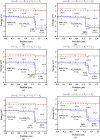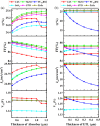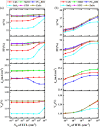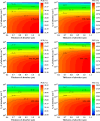Exploration and optimization of different charge transport layers for Cs4CuSb2Cl12 based perovskite solar cells
- PMID: 40646124
- PMCID: PMC12254258
- DOI: 10.1038/s41598-025-10731-6
Exploration and optimization of different charge transport layers for Cs4CuSb2Cl12 based perovskite solar cells
Abstract
Recently, lead-free Cs4CuSb2Cl12 has garnered attention as an excellent material to be used as an absorber of perovskite solar cells (PSCs). In this work, Cs4CuSb2Cl12 absorber-based PSCs were studied and the conditions to get high performance for PSCs were investigated. Here, six different materials for electron transport layers (ETLs) and 10 different materials for hole transport layers (HTLs) were studied. A numerical approach was followed by using SCAPS-1D simulator. During the work, various device parameters of PSC were investigated such as thickness variation of the absorber and ETL layers, acceptor density variation of the absorber and HTL layers, variation of the donor density of the ETL layer, and effect of total defect density of absorber. Also, other parameters such as the impact of resistance, temperature, J-V graph, Q-E graph, and carrier generation rate at different positions of the PSCs were assessed. Among the studied 10 HTL materials, MWCNTs outperformed other studied materials, hence it was selected for further investigations. Then the structures were optimized based on the device parameters outcome, and the structure having MZO and STO ETLs both showed the maximum power conversion efficiency (PCE) of 28.23%. (Al/FTO/MZO/Cs4CuSb2Cl12/MWCNTs/Au) the structure showed an open-circuit voltage (Voc) of 1.249 V, short-circuit current density (Jsc) of 25.11 mA/cm2 and a fill factor (FF) of 90.1%. The performance was also evaluated with respect to key electrical parameters. Optimum performance was achieved at a series resistance of 1 Ω·cm² and a shunt resistance of 1000 Ω·cm², beyond which performance gains saturated. The other best-performing STO ETL-based (Al/FTO/STO/Cs4CuSb2Cl12/MWCNTs/Au) structure had Voc of 1.25 V, Jsc of 25.11 mA/cm2, and FF of 90.01% Under the optimized condition other structure with CdS, PC61BM, SnS2 and ZnSe ETLs showed PCE of 27.68%, 27.8%, 25.67% and 28.22%. This work gives good insights into several Cs4CuSb2Cl12 based PSC structures and shows in the future they have great potential to be developed practically for highly efficient performances.
Keywords: Cs4CuSb2Cl12 absorber; MWCNT HTL; Perovskite solar cell; SCAPS-1D; ZnSe ETL.
© 2025. The Author(s).
Conflict of interest statement
Declarations. Competing interests: The authors declare no competing interests.
Figures











References
-
- Fleck, A. K. & Anatolitis, V. Achieving the objectives of renewable energy policy – Insights from renewable energy auction design in Europe. Energy Policy. 173, 113357 (2023).
-
- Zhang, H., Jing, Z., Ali, S., Asghar, M. & Kong, Y. Renewable energy and natural resource protection: unveiling the nexus in developing economies. J. Environ. Manag.349, 119546 (2024). - PubMed
-
- Zhang, X., Yu, G., Ibrahim, R. L. & Sherzod Uralovich, K. Greening the E7 environment: how can renewable and nuclear energy moderate financial development, natural resources, and digitalization towards the target? Int. J. Sustain. Dev. World Ecol.31, 447–465 (2024).
-
- Han, Z., Zakari, A., Youn, I. J. & Tawiah, V. The impact of natural resources on renewable energy consumption. Resour. Policy. 83, 103692 (2023).
LinkOut - more resources
Full Text Sources

